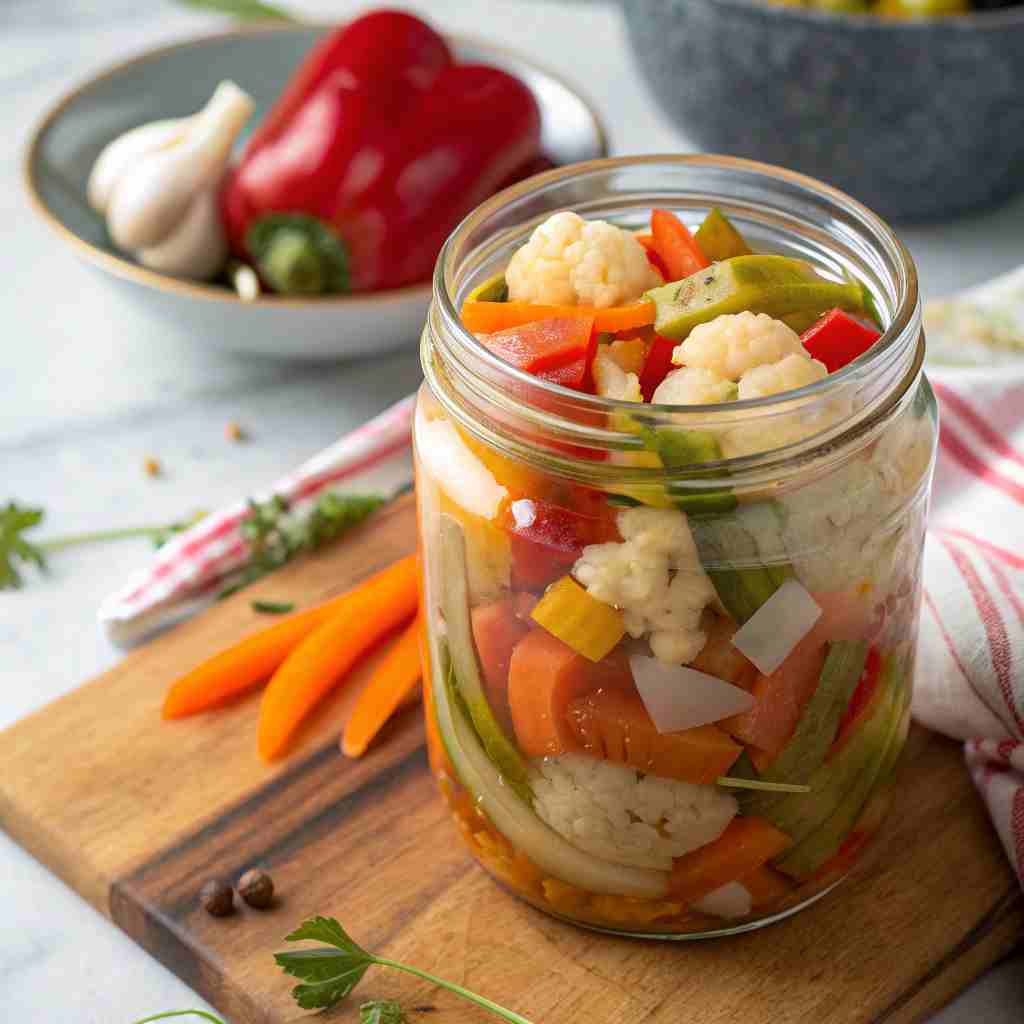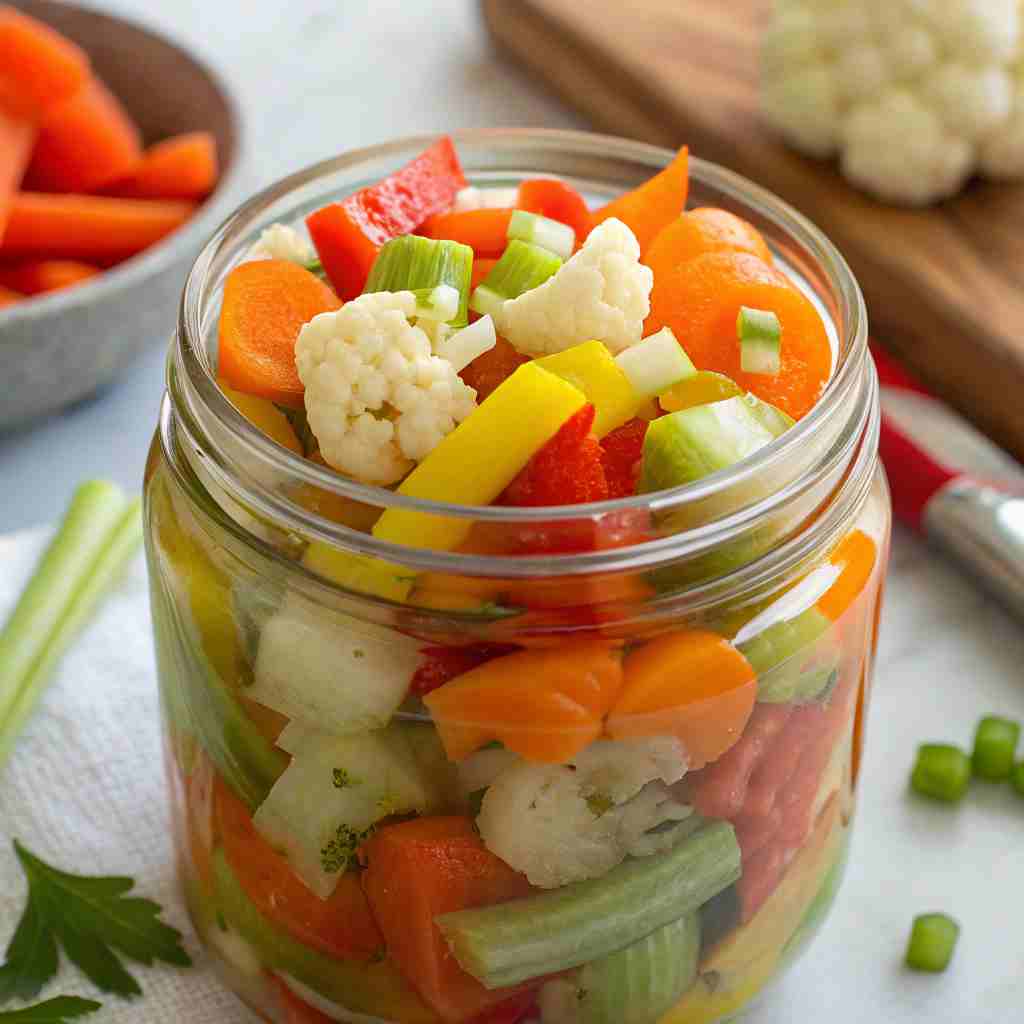Pickled Mixed Vegetables, also known as Giardiniera, is a colorful and tangy medley of crisp cauliflower, carrots, celery, and peppers soaked in a flavorful vinegar brine. This homemade pickle delivers the perfect balance of sweet, sour, and spicy, making it a versatile condiment for sandwiches, salads, antipasto platters, or charcuterie boards. With its crunchy texture and zesty flavor, Giardiniera brings life to any meal.
Easy to make and bursting with freshness, this pickled vegetable mix is a delicious way to preserve your garden bounty and enjoy vibrant flavors all year round.
Table of Contents
What is Pickled Mixed Vegetables?
Pickled Mixed Vegetables, sometimes called Giardiniera, is a vibrant blend of various vegetables preserved in a tangy brine. This is not just a way to extend the life of your seasonal garden haul; it’s a flavorful art form. Think crisp carrots, cauliflower florets, crunchy bell peppers, and spicy peppers, all soaking in a mixture of vinegar, water, salt, sugar, and spices. Each vegetable retains its unique texture and flavor, while the brine infuses them with a delightful tang.
This recipe offers a beautiful balance between sweet, sour, and savory, making it a delightful addition to your snacks or meals. Imagine the satisfying crunch and the refreshing burst of flavor with every bite!
Ready to transform your vegetables into a tangy masterpiece? Let’s get pickling!
Key Ingredients for Pickled Mixed Vegetables:
- 2 cups Cauliflower florets: Choose firm, white cauliflower.
- 1 cup Carrot, peeled and sliced: Use carrots that are firm and brightly colored.
- 1 cup Celery, chopped: Adds a nice crunch.
- 1 cup Bell peppers, any color, seeded and chopped: A mix of colors adds visual appeal!
- 1/2 cup Onion, sliced: Red, yellow, or white onion all work well.
- 1/2 cup Jalapeño peppers, sliced (optional): For a touch of heat. Remove seeds for less spice.
- 4 cloves Garlic, minced: Adds a pungent aroma and flavor.
- 2 cups White vinegar: The base of our pickling brine.
- 1 cup Water: Balances the acidity of the vinegar.
- 1/4 cup Sugar: Enhances the flavor and balances the acidity.
- 2 tablespoons Pickling salt: Essential for preserving the vegetables.
- 1 tablespoon Mustard seeds: Add a slightly spicy and nutty flavor.
- 1 teaspoon Black peppercorns: Provides a subtle pepperiness.
- 1/2 teaspoon Red pepper flakes (optional): For added heat.
- 2 Bay leaves: Contribute a subtle, aromatic flavor.
How to Make Pickled Mixed Vegetables:
This recipe is incredibly simple, allowing you to enjoy a vibrant pickled medley in just a few days. The process involves blanching the vegetables to maintain their crispness, then immersing them in a flavorful brine.
The combination of vinegar, sugar, and spices creates a perfect balance of tang and sweetness. You will only need about 30 minutes to get everything ready, then the pickling process will finish in the jar to allow the flavors to meld together. It’s a delicious, satisfying, and straightforward way to preserve your favorite vegetables.
- Preparation time: 30 minutes
- Rest time: 3 days.
Step-by-Step Instructions:
- Prepare the Vegetables: Wash and chop all the vegetables according to the ingredient list. Ensure the pieces are uniformly sized for even pickling.
- Blanch the Vegetables: Bring a large pot of water to a boil. Add the cauliflower florets and carrots and blanch for 2-3 minutes until slightly tender-crisp. Remove them with a slotted spoon and immediately plunge them into an ice bath to stop the cooking process.
- Layer in Jars: Drain the vegetables well and transfer them to sterilized jars. Add the celery, bell peppers, onion, jalapeño peppers (if using), and minced garlic, distributing them evenly among the jars.
- Prepare the Brine: In a medium saucepan, combine the white vinegar, water, sugar, pickling salt, mustard seeds, black peppercorns, red pepper flakes (if using), and bay leaves. Bring the mixture to a boil, stirring until the sugar and salt are completely dissolved.
- Pour the Brine: Carefully pour the hot brine over the vegetables in each jar, ensuring that all the vegetables are fully submerged. Leave about 1/2 inch of headspace at the top of each jar.
- Remove Air Bubbles: Gently tap the jars on the counter to release any trapped air bubbles. You can also use a clean utensil to press down on the vegetables slightly.
- Seal the Jars: Wipe the rims of the jars clean with a damp cloth. Place the lids on the jars and screw on the bands until they are finger-tight.
- Refrigerate: Allow the jars to cool completely at room temperature, then transfer them to the refrigerator. Let the vegetables pickle for at least 3 days before enjoying. This allows the flavors to meld and develop fully.
Why You’ll Love This Pickled Mixed Vegetables:
What makes this Pickled Mixed Vegetables recipe a winner? The primary highlight is its versatility. It’s a vibrant addition to any meal, perfect for snacking right out of the jar, adding a tangy crunch to sandwiches, or serving as a colorful topping to salads. Second, making pickles at home saves you money from expensive store-bought options, ensuring you control the ingredients and quality. Lastly, adding jalapeños, mustard seeds, and peppercorns makes it flavor-packed.
This recipe stands out from basic cucumber pickles, with the variety of vegetables offering a diverse range of textures and flavors. The medley provides a richer nutritional profile and a more complex taste experience. Ready to elevate your snack game and add zing to your meals? Give this recipe a try and discover the delicious world of homemade pickles!
What to Serve Pickled Mixed Vegetables With:
These Pickled Mixed Vegetables are incredibly versatile and pair well with a variety of dishes:
- Charcuterie Boards: Add a jar of these pickles to your next charcuterie board for a tangy and colorful addition.
- Sandwiches and Wraps: Elevate the flavor of your sandwiches and wraps by adding a spoonful of pickled vegetables. They work particularly well with Italian subs, grilled cheese, or hummus wraps.
- Salads: Sprinkle pickled vegetables over your salads for a crunchy and tangy topping. They pair nicely with green salads, pasta salads, or grain bowls.
- Grilled Meats: Serve alongside grilled chicken, steak, or pork for a refreshing and flavorful contrast.
- Tacos and Quesadillas: Add a spoonful of pickled vegetables to your tacos or quesadillas for an extra burst of flavor and texture.
Top Tips for Perfecting Pickled Mixed Vegetables:
- Use Fresh, High-Quality Vegetables: The quality of your ingredients will directly impact the flavor of your pickles. Use fresh, firm, and high-quality vegetables for the best results.
- Don’t Skip the Blanching Step: Blanching the vegetables helps to preserve their crispness and prevent them from becoming mushy during the pickling process.
- Adjust the Spices to Your Preference: Feel free to adjust the amount of spices to suit your taste. Add more or less jalapeños for a spicier or milder pickle.
- Use Pickling Salt: Pickling salt is pure sodium chloride. Normal table salt may contain iodine which will cause your pickling liquid to darken and may cause a cloudy sediment to form.
- Sterilize Your Jars: Sterilizing your jars is essential to prevent spoilage. Wash the jars, lids, and bands in hot, soapy water, then boil for 10 minutes. Alternatively, you can run them through the dishwasher on the sanitize cycle.
- Allow the Flavors to Meld: The longer the vegetables sit in the brine, the more flavorful they will become. For the best results, allow the pickles to sit in the refrigerator for at least 3 days before enjoying.
Health Benefits of Pickled Mixed Vegetables

Pickled Mixed Vegetables not only tantalize your taste buds but also offer several health benefits. Fermentation is the major health benefit of pickled vegetables. Pickling vegetables allows for the growth of healthy bacteria that are very beneficial for digestive health. Eating pickled vegetablescan help increase good bacteria in the intestine by assisting the digestion process and the absorption of minerals and vitamins.
On top of that, the vegetables themselves contribute vitamins, minerals, and fiber. Cauliflower provides vitamin C and K, carrots offer beta-carotene (vitamin A), and bell peppers are packed with antioxidants. While the sugar and salt content should be considered, enjoying these pickles in moderation can be a delicious and nutritious addition to your diet.
Storing and Reheating Tips:
- Storage: Store the Pickled Mixed Vegetables in the refrigerator in the sealed jars. Properly stored, they can last for several months. Check for any signs of spoilage, such as off-putting odors or excessive cloudiness in the brine, before consuming.
- Reheating: Pickled vegetables are typically served cold, so reheating is not necessary or recommended.
- Freezing: Freezing pickled vegetables is not recommended, as it can alter the texture and make them mushy. It’s best to store them in the refrigerator for long-term preservation.
Final Thoughts:
This Pickled Mixed Vegetables recipe is a delightful way to enjoy the flavors of the garden year-round. Whether you’re looking to preserve your summer harvest or simply add a tangy kick to your meals, this recipe is sure to become a favorite.
Experiment with different vegetables and spices to create your unique blend, and enjoy the delicious and versatile results. Happy pickling!
Read more :
Pickled Mixed Vegetables FAQs:
- Can I use different vegetables? Absolutely! Feel free to experiment with other vegetables such as green beans, asparagus, or radish. Just adjust the blanching time accordingly.
- How long do these pickles last? Properly stored in the refrigerator, these pickles can last for several months to a year.
- Do I need to process these pickles in a water bath canner? This recipe is designed for refrigerator pickling, so water bath canning is not required.
- Can I reduce the amount of sugar? Yes, you can reduce the sugar to your liking. However, keep in mind that sugar helps balance the acidity of the vinegar, so adjusting the amount may affect the overall flavor.
- What is pickling salt? Pickling salt is used because it doesn’t contain iodine and other additives that may cause changes in color. Table salt can be used, but it may make your pickles cloudy.

